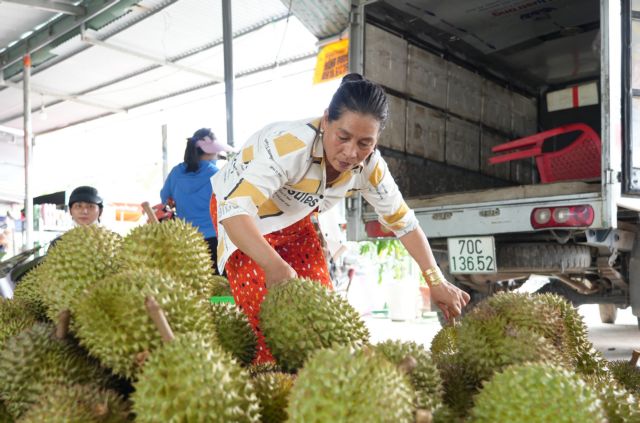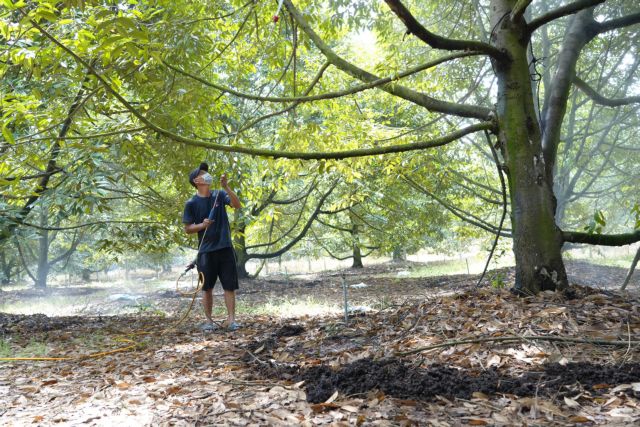 Society
Society

 |
| Traders purchase durians. — VNA/VNS Photos |
TÂY NINH — The strong increase in exports and the high price of durian have encouraged many farmers in Tây Ninh Province to boldly switch from economically inefficient crops to cultivating durian trees, bringing higher income.
The area of durian cultivation has increased by approximately 1,000ha compared to 2021, bringing the total durian cultivation area in the province to nearly 3,000ha, according to the provincial Department of Agriculture and Rural Development (DARD).
This area is expected to reach about 5,000ha by 2025, following a direction of high-tech agriculture, supply chain integration and serving export.
Tây Ninh Province now has three farming area codes and one packaging facility for export.
The province is currently applying for additional area codes for durian cultivation, with the goal of achieving 50 farming area codes to serve the export market. The issuance of area codes for durian cultivation must meet certain conditions, including good production practices, disease control measures, management issues, and training for farmers.
Nguyễn Đình Xuân, director of the DARD said, previously, it took farmers about seven to eight years to harvest durian, but now it only takes about four years.
The average yield ranges from five to 10 tonnes per hectare, depending on the size of the trees.
In the Bàu Đồn fruit cooperative in Gò Dầu District, the farmers can collect over 20 tonnes per hectare of durian.
The average price is around VNĐ50,000 (US$2.10) per kilogram, and farmers can earn profits ranging from VNĐ250 million ($10,590) to VNĐ1 billion ($42,390) per hectare from growing durian.
Meanwhile, one hectare of cassava, sugarcane, or rice only brings an income of about VNĐ100 million per year.
Durian cultivation provides significantly higher income compared to other crops, according to Xuân.
The durian area of the family of Trần Văn Chon, a farmer from Hamlet 7, Bàu Đồn Commune, is 2ha.
In this year's crop, his family harvested over 54 tonnes of durian. With a price above VNĐ50,000 per kilogram, his family earned around VNĐ2.7 billion.
Chon said that since joining the Bàu Đồn fruit cooperative three years ago, his family had received support in terms of loans, seedlings, fertilisers, and technical assistance. As a result, their durian yield consistently achieved high productivity.
Phan Hoài Thịnh, director of Bàu Đồn Fruit Cooperative, said the previous area for planting durian in the cooperative was 45ha with 32 members. Now the farming area had expanded to 120ha with 62 members. Thanks to local authorities providing technical training and registration of farming area codes, the co-operative had been granted VietGAP and One Commune One Product certification with four stars.
Every year, the cooperative had to invest VNĐ100-200 million per hectare for durian cultivation. The cooperative's products were being consumed in supermarkets in HCM City, Đà Nẵng, Huế and Hà Nội and they are highly regarded for their quality, Thịnh said.
The cooperative had partnered with three major enterprises to export durian to China.
 |
| A farmer takes care of durian trees after harvest. |
For this year's durian crop, the cooperative harvested an average yield of 25 to 27 tonnes per hectare.
The conversion from less efficient crops to cultivating durian trees for higher income was in line with the agricultural development direction of the province, said agriculture director Xuân.
However, the development of durian farming must follow the right methods, be suitable for the soil conditions, and apply science and technology, as well as keep close links with market supply chains.
If farmers want to switch to planting durian, they need to carefully evaluate the soil conditions and make the right investments in terms of both quantity and techniques to ensure effectiveness, according to Chon.
The massive investment in durian planting will lead to the risk of oversupply, surplus and price drops. That is unavoidable.
Chon has recommended that relevant departments and local authorities provide the appropriate attention, plan the cultivation areas, and support funding and technical assistance to ensure the sustainable development of durian in Tây Ninh Province in the future. Agriculture director Xuân said the province is a favourable region for durian cultivation, especially for the Ri6 and Monthong varieties.
The durian season in Tây Ninh is later than in other provinces in the southwest region and earlier than in the Central Highlands, helping durian growers to supply their products to the market.
Furthermore, the province is less affected by natural disasters and is not prone to droughts and frequent storms or floods. In particular, Tây Ninh has fertile soil, good drainage, and a well-planned irrigation system.
Xuân said durian cultivation required farmers to invest a significant amount of capital in the long term.
Ensuring proper farming techniques and soil conditions would bring products with the right standards and the highest profits. Otherwise, the efficiency would not be as expected.
Currently, the market had a high demand for durian fruits, partly due to increased purchases from China, said Xuân.
However, it was unpredictable when the durian market would become saturated. Farmers needed to consider sustainable and cautious investments to mitigate risks. — VNS